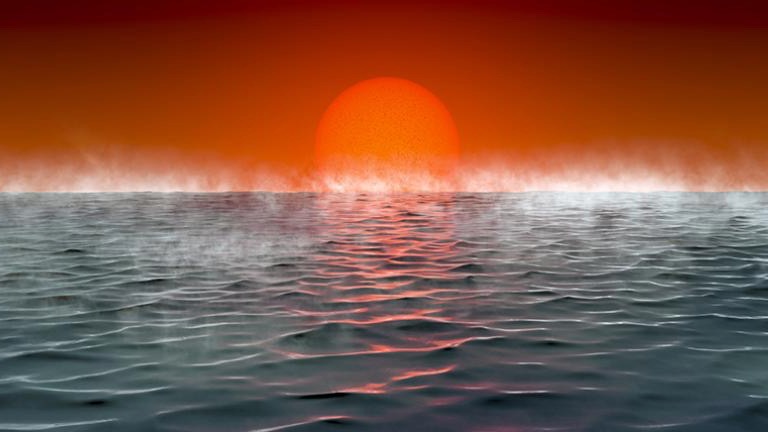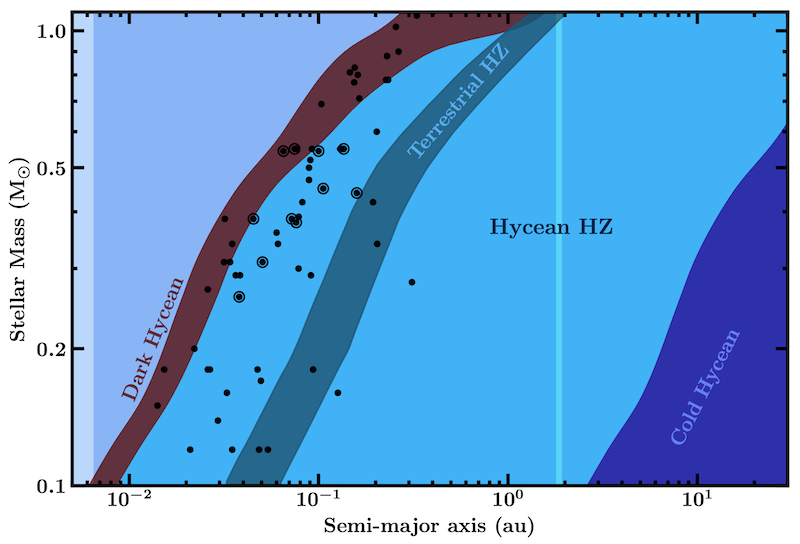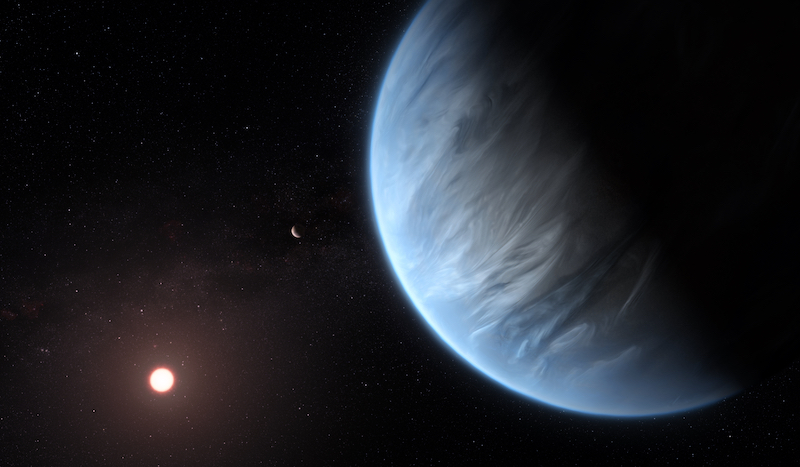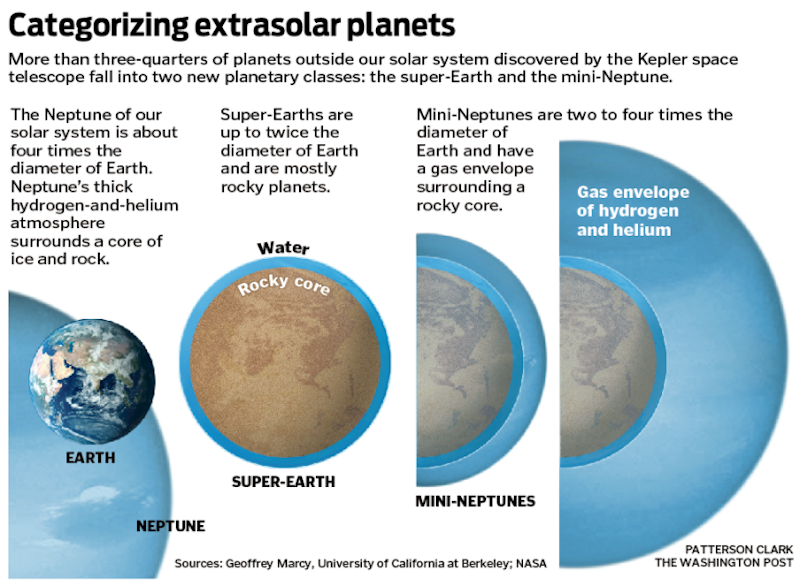
Is there life beyond Earth? It seems extremely probable, although we still don’t have the hard evidence. But astronomers said on August 26, 2021, that they’ve identified a new class of exoplanets that are a big step forward in the search for life. They’re calling them Hycean worlds, from the words hydrogen and ocean. Planet-wide oceans and hydrogen-rich atmospheres might cover these worlds. And yet, the researchers said, they might be habitable.
Researchers from the University of Cambridge led this intriguing research. The peer-reviewed Astrophysical Journal published it on August 26.
Hycean planets: Like Earth but different
According to the researchers, Hycean worlds could greatly accelerate the search for life elsewhere. In some ways they are reminiscent of Earth, largely or even completely covered by oceans. Yet they are also uniquely alien: up to 2.6 times the diameter of Earth, with temperatures up to 200 degrees C (about 400 degrees F) and thick hydrogen atmospheres. This places them somewhere between Earth and giant planets like Neptune or Uranus.
Indeed, many such worlds in this size range are already known to exist, the super-Earths and mini-Neptunes. Scientists say that planets in this size range are the most common in our galaxy.
There may also be different kinds of Hyceans, including “dark” and “cold.” As noted in the paper:
Our investigations include tidally locked “Dark Hycean” worlds that permit habitable conditions only on their permanent nightsides and “Cold Hycean” worlds that see negligible irradiation [receive little radiation from their stars].

Super-Earths, mini-Neptunes and Hyceans
Super-Earths are rocky but larger than Earth. Even now, little is known about what kinds of atmospheres they have, although some have been found in the habitable zones of their stars where temperatures could allow liquid water. Mini-Neptunes though have long been thought to be inhospitable for life as we know it. Most mini-Neptunes lack a solid surface and the temperatures and pressures in their atmospheres would make it very difficult for life to evolve.
What the new study suggests, however, is that some of those worlds may be able to support life after all. Those are the Hyceans. As lead author Nikku Madhusudhan at the University of Cambridge stated:
Hycean planets open a whole new avenue in our search for life elsewhere.
Are Hycean planets habitable?
How, then, might Hycean planets be habitable? Having plentiful liquid water is of course a good start. These planets, unlike most mini-Neptunes, may have solid surfaces, like Earth. Many of the known Hycean candidates are larger and hotter than Earth, but still would be able to host large oceans, the researchers say. The conditions might be similar to some of the more extreme aquatic environments on our planet, but could theoretically still support at least microbial life.

By their nature, these planets would also mean that the habitable zones around their stars could be a lot larger than those in systems with Earth-like planets. That’s another plus for the possibility of life. The habitable zone is the region around a star where temperatures would be suitable for liquid water on the surface of a rocky planet.
Another previous study, of the mini-Neptune K2-18b, supports the possibility of habitable Hycean worlds. Based on this study, scientists identified the new class of exoplanets, the Hyceans. While some scientists refer to K2-18b as a super-Earth, most now classify it as a mini-Neptune.
Looking for biosignatures
So, how would astronomers look for evidence of life on any of these worlds? They will search for biosignatures, chemical fingerprints of biological processes in the planets’ atmospheres. Some common ones are oxygen, ozone, methane and nitrous oxide, as well as methyl chloride and dimethyl sulphide. The last two are not common on Earth, but might be on hydrogen-rich planets. According to Madhusudhan:
Essentially, when we’ve been looking for these various molecular signatures, we have been focusing on planets similar to Earth, which is a reasonable place to start. But we think Hycean planets offer a better chance of finding several trace biosignatures.

Madhusudhan and his team say that many of these biosignatures should be easily detectable on Hycean planets. In fact, the nature of the planets themselves – larger sizes, higher temperatures and hydrogen-rich atmospheres – means that the biosignatures would be even more easily detectable than on Earth-like planets. From the paper:
We find that a number of trace terrestrial biomarkers that may be expected to be present in Hycean atmospheres would be readily detectable using modest observing time with the James Webb Space Telescope (JWST). We identify a sizable sample of nearby potential Hycean planets that can be ideal targets for such observations in search of exoplanetary biosignatures.
Upcoming observations
Excitingly, it might not be too long before we get some good spectroscopic observations of some Hycean planets. Astronomers already have a good sampling of candidate Hycean-type worlds to study, and upcoming space telescopes like the James Webb Space Telescope (the Webb) will be able to analyze their atmospheres. All the candidates are fairly close, from 35 to 150 light-years away, and orbit red dwarf stars.
K2-18b is currently the primary Hycean candidate, and observations with the Webb, which will launch sometime after October 31 this year, are already planned.

If any of these candidate Hyceans do in fact support life, the upcoming studies with the Webb and other telescopes have a good chance of detecting signs of it. As Madhusudhan noted:
A biosignature detection would transform our understanding of life in the universe. We need to be open about where we expect to find life and what form that life could take, as nature continues to surprise us in often unimaginable ways.
Astronomers also announced last July that another mini-Neptune, TOI-1231 b, has a deep atmosphere ideal for further study by the Webb and the Hubble Space Telescope. It will be exciting to see what future observations of worlds like this, and Hyceans in particular, reveal.
Bottom line: Astronomers at the University of Cambridge have identified a new class of potentially habitable exoplanets called Hyceans. These are huge, hot worlds that could be covered by oceans and have thick hydrogen atmospheres.
Source: Habitability and Biosignatures of Hycean Worlds
Source (preprint): Habitability and Biosignatures of Hycean Worlds
Science - Latest - Google News
August 29, 2021 at 07:06PM
https://ift.tt/3gGL2Nw
Hycean planets might be habitable ocean worlds - EarthSky
Science - Latest - Google News
https://ift.tt/2Kb7H4e
https://ift.tt/3ceUkwc
Bagikan Berita Ini

















0 Response to "Hycean planets might be habitable ocean worlds - EarthSky"
Post a Comment